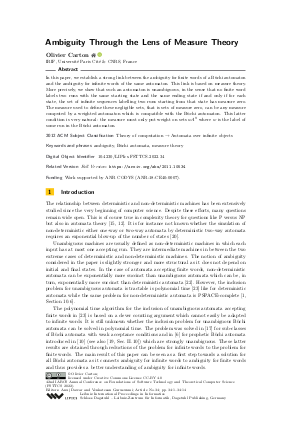Ambiguity Through the Lens of Measure Theory
Author
Olivier Carton 
-
Part of:
Volume:
42nd IARCS Annual Conference on Foundations of Software Technology and Theoretical Computer Science (FSTTCS 2022)
Part of: Series: Leibniz International Proceedings in Informatics (LIPIcs)
Part of: Conference: IARCS Annual Conference on Foundations of Software Technology and Theoretical Computer Science (FSTTCS) - License:
 Creative Commons Attribution 4.0 International license
Creative Commons Attribution 4.0 International license
- Publication Date: 2022-12-14
File

PDF
LIPIcs.FSTTCS.2022.34.pdf
- Filesize: 0.67 MB
- 14 pages
Document Identifiers
Related Versions
- Full Version https://arxiv.org/abs/2011.10534
Subject Classification
ACM Subject Classification
- Theory of computation → Automata over infinite objects
Keywords
- ambiguity
- Büchi automata
- measure theory
Metrics
- Access Statistics
-
Total Accesses (updated on a weekly basis)
0Document
0Metadata
Abstract
In this paper, we establish a strong link between the ambiguity for finite words of a Büchi automaton and the ambiguity for infinite words of the same automaton. This link is based on measure theory. More precisely, we show that such an automaton is unambiguous, in the sense that no finite word labels two runs with the same starting state and the same ending state if and only if for each state, the set of infinite sequences labelling two runs starting from that state has measure zero. The measure used to define these negligible sets, that is sets of measure zero, can be any measure computed by a weighted automaton which is compatible with the Büchi automaton. This latter condition is very natural: the measure must only put weight on sets wA^ℕ where w is the label of some run in the Büchi automaton.
Cite As Get BibTex
Olivier Carton. Ambiguity Through the Lens of Measure Theory. In 42nd IARCS Annual Conference on Foundations of Software Technology and Theoretical Computer Science (FSTTCS 2022). Leibniz International Proceedings in Informatics (LIPIcs), Volume 250, pp. 34:1-34:14, Schloss Dagstuhl – Leibniz-Zentrum für Informatik (2022)
https://doi.org/10.4230/LIPIcs.FSTTCS.2022.34
BibTex
@InProceedings{carton:LIPIcs.FSTTCS.2022.34,
author = {Carton, Olivier},
title = {{Ambiguity Through the Lens of Measure Theory}},
booktitle = {42nd IARCS Annual Conference on Foundations of Software Technology and Theoretical Computer Science (FSTTCS 2022)},
pages = {34:1--34:14},
series = {Leibniz International Proceedings in Informatics (LIPIcs)},
ISBN = {978-3-95977-261-7},
ISSN = {1868-8969},
year = {2022},
volume = {250},
editor = {Dawar, Anuj and Guruswami, Venkatesan},
publisher = {Schloss Dagstuhl -- Leibniz-Zentrum f{\"u}r Informatik},
address = {Dagstuhl, Germany},
URL = {https://drops.dagstuhl.de/entities/document/10.4230/LIPIcs.FSTTCS.2022.34},
URN = {urn:nbn:de:0030-drops-174269},
doi = {10.4230/LIPIcs.FSTTCS.2022.34},
annote = {Keywords: ambiguity, B\"{u}chi automata, measure theory}
}
Author Details
Funding
Work supported by ANR CODYS (ANR-18-CE40-0007).
References
-
A. V. Aho, J. E. Hopcroft, and J. D. Ullman. The Design and Analysis of Computer Algorithms. Addison-Wesley, 1974.

-
V. Becher and O. Carton. Normal numbers and computer science. In V. Berthé and M. Rigo, editors, Sequences, Groups, and Number Theory, Trends in Mathematics Series, pages 233-269. Birkhäuser, 2018.

-
J. Berstel and D. Perrin. Theory of Codes. Academic Press, 1984.

-
J. Berstel and Ch. Reutenauer. Noncommutative Rational Series with Applications. Cambridge University Press, 2010.

-
É. Borel. Les probabilités dénombrables et leurs applications arithmétiques. Rendiconti Circ. Mat. Palermo, 27:247-271, 1909.

- N. Bousquet and Ch. Löding. Equivalence and inclusion problem for strongly unambiguous Büchi automata. In LATA 2010, volume 6031 of Lecture Notes in Computer Science, pages 118-129. Springer, 2010. URL: https://doi.org/10.1007/978-3-642-13089-2_10.
-
M. Boyle and K. Petersen. Entropy of Hidden Markov Processes and Connections to Dynamical Systems, volume 385 of London Mathematical Society Lecture Notes, chapter Hidden Markov processes in the context of symbolic dynamics, pages 5-71. Cambridge University Press, 2011.

-
P. Brémaud. Markov Chains: Gibbs Fields, Monte Carlo Simulation, and Queues. Springer, 2008.

- O. Carton. Preservation of normality by unambiguous transducers. CoRR, abs/2006.00891, 2022. URL: http://arxiv.org/abs/2006.00891.
-
O. Carton and M. Michel. Unambiguous Büchi automata. Theoret. Comput. Sci., 297:37-81, 2003.

-
Ch. Choffrut and S. Grigorieff. Uniformization of rational relations. In Jewels are Forever, Contributions on Theoretical Computer Science in Honor of Arto Salomaa, pages 59-71. Springer, 1999.

-
Th. Colcombet. Unambiguity in automata theory. In Descriptional Complexity of Formal Systems, volume 9118 of Lecture Notes in Computer Science, pages 3-18. Springer, 2015.

-
P. R. Halmos. Lectures on Boolean algebras. Von Nostrand, 1963.

-
G. Hansel and D. Perrin. Mesures de probabilité rationnelles. In M. Lothaire, editor, Mots, pages 335-357. Hermes, 1990.

- M. Holzer and M. Kutrib. Descriptional complexity of (un)ambiguous finite state machines and pushdown automata. In Reachability Problems, pages 1-23. Springer, 2010. URL: https://doi.org/10.1007/978-3-642-15349-5_1.
-
J. E. Hopcroft and J. D. Ullman. Introduction to Automata Theory, Languages, and Computation. Addison-Wesley, 1979.

-
D. Isaak and Ch. Löding. Efficient inclusion testing for simple classes of unambiguous ω-automata. Inf. Process. Lett., 112(14-15):578-582, 2012.

-
D. Lind and B. Marcus. An Introduction to Symbolic Dynamics and Coding. Cambridge University Press, 1995.

-
D. Perrin and J.-É. Pin. Infinite Words. Elsevier, 2004.

- G. Pighizzini. Two-way finite automata: Old and recent results. Electronic Proceedings in Theoretical Computer Science, 90:3-20, 2012. URL: https://doi.org/10.4204/eptcs.90.1.
-
J. Sakarovitch. Elements of Automata Theory. Cambridge University Press, 2009.

- E. Schmidt. Succinctness of descriptions of context-free, regular, and finite languages. DAIMI Report Series, 7(84), 1978. URL: https://doi.org/10.7146/dpb.v7i84.6500.
- R. E. Stearns and H. B. Hunt III. On the equivalence and containment problems for unambiguous regular expressions, regular grammars and finite automata. SIAM J. Comput., 14(3):598-611, 1985. URL: https://doi.org/10.1137/0214044.
